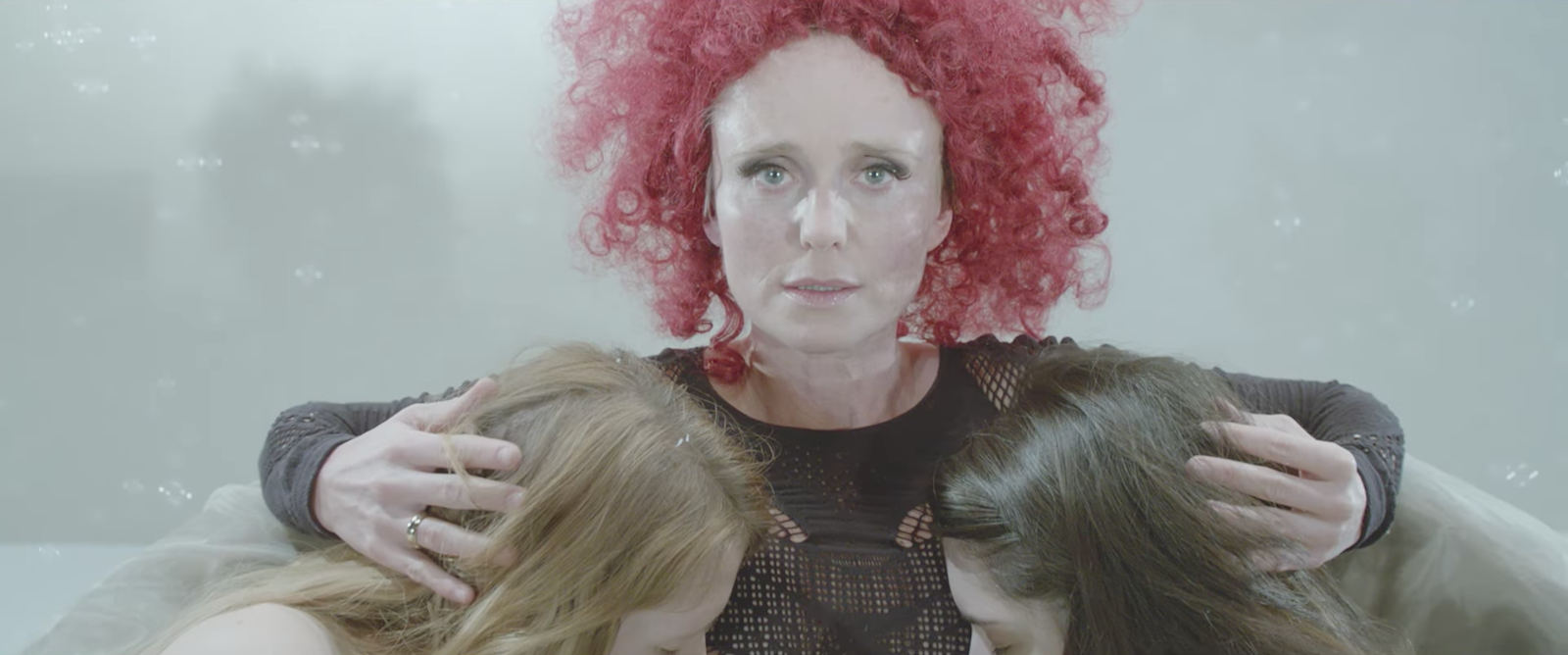The odds were stacked against director Michael Verhoeven’s horror feature Friend Request from the beginning. The film is a German production shot in South Africa with a stable of English-speaking actors. Combined with a sub-$10 million budget, that Frankenstein provenance results in a predictably non-specific setting. It’s implied that the film unfolds in a posh Southern California coastal city, but the necessary geographical caginess and the generally chintzy production values give the whole enterprise a glum air of disposability. The film’s zeitgeist-pandering central conceit—a Facebook-mediated haunting—not only promises tedious Luddite moralizing and kludgy imitations of post-Millennial slang, it’s also virtually guaranteed to age poorly. Indeed, Verhoeven’s feature was shot in 2014, and given the present pace of Internet culture's evolution, it already feels faintly dated, a relic from the hoary days of the Ice Bucket Challenge, the potato salad Kickstarter, and “Let It Go” parody videos.
It’s therefore pleasantly surprising that Friend Request isn’t a complete pile of dogshit. Sure, it’s inarguably lazy, recycling plot beats and design elements from 20 years’ worth of American J-horror clones. It’s stupid as hell, weighed down by a screenplay replete with tin-eared corporate approximations of How Kids Talk These Days. Perhaps most obnoxiously, the film proffers precisely the smug messaging suggested by the trailers: Anyone who is introverted and socially awkward must be a murderously insane necromancer, especially if their personal aesthetic can be described as "black and slightly darker black." Still, Verhoeven’s film is low-rent ghoulish fun, and even intermittently inspired in terms of its visual and sound design. For all its insipidness, Friend Request is rarely outright boring, and whenever it briefly lurches from Entertainingly Bad Movie to Annoyingly Bad Movie, it generally rights itself with its schlocky, R-rated haunted house shocks.
The scenario is pure thirty-second studio pitch material, and if one has seen the trailer, one already knows everything essential there is to know about the plot. Sophomore psychology student Laura (Alycia Debnam-Carey) is pretty, outgoing, and popular, as evidenced by her 800-plus Facebook friends. (The film is never entirely clear whether the social media friend count as a yardstick of personal success is meant to be taken satirically or not, although given the screenplay’s overall brainlessness, one suspects the latter.) Laura lives off-campus with her flamboyant friends Olivia (Brit Morgan), Isabel (Brooke Markham), and Gustavo (Sean Marquette). She is currently dating handsome surfer and medical student Tyler (William Moseley), and rounding out her immediate social circle is tattooed computer geek Kobe, who, not incidentally, harbors an unrequited crush on Laura.
One day an offhand smile at her reclusive classmate Marina (Liesl Ashlers) nets Laura a Facebook friend request. Marina is something of an amateur video artist with a goth bent—her timeline is dense with ravens, dead trees, and severed doll heads—and Laura initially takes a shine to her talent, even though the girl has (gasp!) zero Facebook friends. Laura accepts the request, but in short order she regrets that fateful click. Marina is needy and aggressively unctuous, bombarding Laura with posts and direct messages as though they were suddenly best friends. When Laura lies about her birthday party to spare Marina’s feelings, the latter girl unsurprisingly spots the evidence on Laura’s timeline, resulting in a public confrontation and virtual unfriending. This proves to be too much for the fragile Marina, who subsequently commits suicide by hanging and self-immolation, filming and auto-posting this final act online.
A little thing like death isn’t much of a deterrent to a truly determined cyber stalker, however. It turns out that Marina’s ritualistic suicide is the opening move in an elaborate revenge plot against Laura, a scheme that seems to have two prongs. First, Laura’s friends and family are soon plagued by terrifying hallucinations, most of them involving swarms of black wasps, a pair of mutilated boys, and a decrepit, demonic incarnation of Marina’s spirit. These visions gradually drive the people in Laura’s immediate social circle to commit suicide, one by one. Meanwhile, Laura’s Facebook profile is hijacked by a mysterious presence, which proceeds to post videos of her friends’ gruesome deaths and otherwise make her look like a horrible person. Laura swiftly finds herself under investigation by university and police authorities, and—the horror!—ostracized by outraged Facebook friends, who abandon her in droves. (Her steadily dropping friend count recurs as an animated, on-screen flourish.)
The most vexing thing about Friend Request’s plot is that it feels like a missed opportunity for a much more ambitious and ruthless horror film. At risk of indulgently imagining the story that might have been, Verhoeven and co-writers Matthew Ballen and Phillip Koch could have easily expanded Marina’s death list to include everyone on Laura’s friend list, instead of confining the ghost-driven suicides to her closest pals. The ghastly spectacle practically writes itself: montages of dozens of suicides, from the crude to the baroque, as the 800-plus digital connections Laura has made become the proverbial mark of damnation. (And fuck you, Friend Request, for eliciting this thought: The Happening did it better.) The mass exodus from her friend list would thereby take on the urgency of a hysterical mob fleeing a burning building, rather than, say, the mere disgusted unfriending of an old high school classmate with a pro-Trump meme on their timeline.
Verhoeven is primarily interested in hewing to the template of a slasher-informed vengeful ghost story, bumping off Laura’s closest friends one at a time in spooky set pieces laden with jump scares. Laura’s pals are little more than hastily sketched clusters of attributes, and as such the hallucinations that Marina inflicts on them aren’t custom-tailored in any meaningful way. She just relentlessly pummels them with spectral shocks, reducing each person to a frazzled, hollow-eyed wreck who ultimately surrenders to the hypnotic lure of death. It’s an unimaginative but solid enough approach to the story, and Friend Request benefits from the director’s facility for said jump scares, which feature enjoyably off-kilter timing, potent sound design, and some creepy digital and makeup effects. It’s pedestrian as can be, but executed skillfully enough to be grisly fun rather than a dreary slog.
Nothing about Friend Request stands out as truly memorable, but there are stimulating flashes in the story and design that lend the proceedings some vigor, at least in the moment. The underlying occult conceit is admittedly clever, positioning the blank computer screen as the 21st century version of a diabolist’s black scrying mirror. The second half of the film essentially follows The Ring’s road map, as Laura and Kobe dig into Marina’s troubled history and try to determine the secret location where she filmed her suicide. Fortunately, these Nancy Drew passages compliment rather than water down the hallucinatory set pieces, and Verhoeven blessedly resists wedging a contrived, late film twist into the secrets that Laura uncovers. (There is a third act plot swerve, but it’s both plausible and neatly foreshadowed while still managing to shock.) The film makes liberal use of the animated pop-ups that have become a mainstay of post-iPhone filmmaking, but it does so with a fleet, almost impressionistic sensibility that doesn’t visually distract. Occasionally, the filmmakers even deliver some downright marvelous aesthetic touches, such as the way that Gary Go and Martin Todsharow’s score suggests the distinctive sound of cellular interference with audio equipment whenever Marina draws near.
When one moves beyond the proximal scares and formal polish and into the underlying thematic territory, however, Friend Request starts to unravel. Given the speed with which Laura’s online friends huffily abandon her, Verhoeven and his co-writers seem to be commenting on social media insta-outrage and the fickleness of the Internet mob, but what exactly that comment might be is anyone’s guess. The film’s overall ethos has a whiff of lazy cynicism. Broadly speaking, Friend Request seems to proffer a facile anti-technology pessimism, the same sort of tongue-clucking that drives countless, insipid “Are We Addicted to Social Media?” think pieces and (ironically) hand-wringing memes about Kids Today and their damn smartphones. Yet the film’s attempts to critique and satirize digital culture are clearly half-hearted, as if Verhoeven doesn’t really buy into this Luddite finger wagging, but is obliged to advance it because of his story’s fundamental premise. (The recent Ingrid Goes West is far more cunning and pitiless about pushing the curated lies of social media to their reductio ad absurdum limits, and it ultimately emerges as a much better horror film, if a stealth one.)
Cheap cynicism is easy enough to overlook in the horror genre, but the most distressing aspect of Friend Request is its absurdly blinkered treatment of anyone who seems strange, awkward, or non-conforming in some way. Verhoeven’s film poses, with a straight face, the notion that introverted weirdos are all deranged, damaged monsters who, if given half a chance, would eagerly use black magic to kill happy, successful, popular people. It’s petty high school bullshit of the crudest sort, rendered downright silly by the film’s conflation of the Movie Version of goth sub-culture (Skulls! Poe! Marilyn Manson!) with the darkest evil imaginable. Paradise Lost should have invalidated such nonsense forever, yet here it seems intended to elicit a shrug or even a nod of agreement.
What’s more, Friend Request advances that Laura’s original sin was not in spurning Marina, but in taking an interest in the clingy, creepy outcast at all. In the film’s conception, any kind of creative expression is a friendship red flag—unless, of course, it generates dollars, fame, and clicks. (It bears noting that Marina creates her animated videos primarily for herself in order to cope with horrible childhood trauma.) Art doesn't count, apparently, unless it's Shared. Ultimately, the film’s perhaps unintentional yet repugnant message is that one shouldn’t even acknowledge someone who lacks Instagram followers, because that person is almost certainly unstable.









